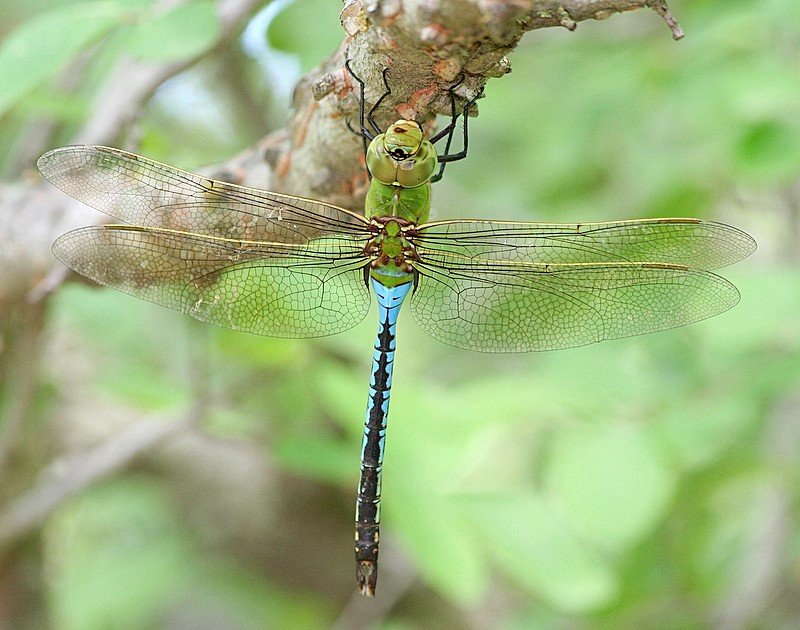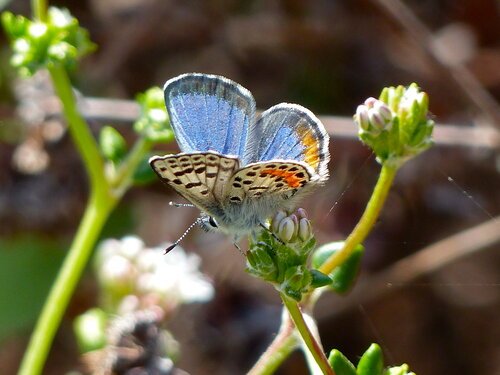INSECTS
BLUE-EYED DARNER (Rhionaeschna multicolor)
Fun Fact: Despite its name, females of the species are not, in fact, blue eyed.
Diet: Small lifeforms.
Habitat: Lakes, ponds, marshes, and slow streams.
Overview: Found across the Western United States, the males of the species feature beautiful turquoise blue markings and eyes, while females of the species exhibit a brown coloration with green markings. Like others, it features the characteristic transparent wings.
Photo Credit: Pierre Deviche
Resources: MT Field Guide
https://fieldguide.mt.gov/speciesDetail.aspx?elcode=IIODO14100
COMMON GREEN DARNER (Anax junius)
Fun Fact: Easily sexed, the green darner males display a bright blue coloration on their abdomen.
Diet: Small lifeforms, such as mosquito larvae.
Habitat: Ponds, marshes, streams.
Overview: Swift flying and colorful, the common green darner can be found across much of the country. Adult males have bright blue abdomens and green elsewhere, while the abdomens of females and young males is a brownish green.
Photo Credit: Texas Eagle, https://www.flickr.com/photos/texaseagle/2668969066
Resources: MT Field Guide
https://fieldguide.mt.gov/speciesDetail.aspx?elcode=IIODO15020
EL SEGUNDO BLUE BUTTERFLY (Euphilotes allyni)
Fun Fact: This thumbnail-sized butterfly is an LA native and is Federally Endangered. Its territory was nearly entirely destroyed by housing developments in the 20th century, the construction of LAX and the subsequent moratorium on building around it is likely what saved this enigmatic insect.
Diet: Seacliff buckwheat flowers and seeds as caterpillar, nectar as an adult.
Habitat: Coastal sand dunes and bluffs.
Overview: The El Segundo Blue is restricted to what remains of sea dunes around the LA basin’s coastline and habitat loss coupled with the loss of the butterfly’s host plant, Seacliff Buckwheat, has caused population numbers to drop dramatically. This butterfly can be rarely spotted in Ballona’s dune section, and thanks to conservation efforts by many organizations, the population of this strikingly colorful insect is on the rise.
Photo credit: Patrick Tyrell
Resources: Xerces Society
https://xerces.org/endangered-species/species-profiles/at-risk-butterflies-moths/el-segundo-blue
www.esbcoaliton.org
GRAY HAIRSTREAK (Strymon melinus)
Fun Fact: The Gray Hairstreak lays its eggs on the flowers of the host plant, and younger caterpillars will eat the flowers and fruit of said plant, while the older caterpillars may eat the leaves as well.
Diet: Nectar as adult, most plants as caterpillar.
Habitat: Open areas, weedy patches, fields.
Overview: Gray tinted with orange accents, Strymon melinus takes on a darker shade of gray in the spring and fall, and a lighter coloration in the summer. Ranging predominantly across North America and into Central America, the Gray Hairstreak can live off of many common plant species, such as clovers and peas, the adult can be attracted by planting native goldenrod bushes and milkweeds.
Photo Credit: Vitaly Charny
Resources: Butterflies and Moths
https://www.butterfliesandmoths.org/species/Strymon-melinus
MONARCH BUTTERFLY (Danaus plexippus)
Fun Fact: The Western Monarch and Eastern Monarch migrate along the west and east side of the rocky mountains respectively, and the more common Western monarch tends to overwinter in California, while Western monarchs travel from near the Canada-US border to Mexico–a distance 10 times as far as their Western counterpart!
Diet: Nectar as adult, milkweed as caterpillar.
Habitat: Varied; all along their migration paths, favoring meadows and groves with roosting and feeding locations, (Seaside groves in California, and Oyamel fir forests in Mexico.)
Overview: Among the most iconic butterflies, the black, white, and orange Monarch travels staggering distances across nearly three countries, and can be seen across much of the central and western united states. The species’ host plant, milkweed, comes in many different species native to different climates. It is essential that butterfly gardeners plant native species, like Narrow-leaf Milkweed.
Resources: Xerces Society
SALTMRASH MOTH (Estigmene acrea)
Fun Fact: The name of this species does not come from the fact that it lives in salt marshes, rather, it was named after dwelling in fields of saltgrass hay–that itself being an anomaly, as the moth tends to prefer other plants to grasses.
Diet: Pigweed, clovers, nightshades, milkweeds, and garden crops.
Habitat: Fields, woods, meadows, and marshes.
Overview: Beautifully colored moths, males of the species have orange hindwings, while the female has white hindwings. Both sexes have black spots across their wings and thorax. Larvae of the species change color as they grow, but tend to have orange-yellow highlights, and are quite hairy.
Resources: Moth Identification
https://www.mothidentification.com/salt-marsh-moth.htm
SONORAN BUMBLEBEE (Bombus sonorus)
Fun Fact: Extremely threatened, like other native bumblebee species, the Sonoran Bumblebee is the de facto bumblebee of the Sonoran and Chihuahuan desert areas.
Diet: Pollen and nectar; nightshades, mallows, clovers, thistles, etc.
Habitat: Deserts, foothills, coastal areas.
Overview: Highly vulnerable, the Sonoran Bumblebee features dark fuzz, amber wings, and multiple rings of honey colored fuzz around the abdomen. The species ranges across the southwestern states and into Mexico, though its abundance in the states has dropped dramatically due to pesticide use and habitat loss, as well as competition with invasive honeybees.
Resources: Bug Guide
https://bugguide.net/node/view/95153
WANDERING SKIPPER (Panoquina errans)
Fun Fact: Caterpillars of this species hide away in shelters of rolled or tied leaves, only emerging at night to feed.
Diet: Nectar as adult, saltgrass as caterpillar.
Habitat: Salt marshes.
Overview: Wandering Skippers are olive coloured butterflies whose host plant, saltgrass, can be found growing throughout the salt marsh area of the wetlands. Pale markings can be seen along the backs of their wings, and the butterfly adults are receptive to most highly attractive plants.
Photo credit, Resources: Butterflies and Moths
https://www.butterfliesandmoths.org/species/Panoquina-errans
YELLOW FACED BUMBLEBEE (Bombus vosnesenskii)
Fun Fact: The most common of the native bumblebees, there is some controversy over the existence of other species in the Bombus genus as they share only slightly different DNA and other markers.
Diet: Pollen and nectar; california poppies, deerweed, goldenbush, etc.
Habitat: Chaparral, oak woodland, coastal area, and gardens.
Overview: They can be found across the west coast, from california up into the provinces of Canada. Like other bumblebees, these insects require leaf litter to thrive, as well as a wide variety of pollinator plants. Workers feature black, fuzzy bodies with a ring of golden fuzz around the abdomen, as well as on the head and upper thorax.
Resources: Discover Life
https://www.discoverlife.org/mp/20q?search=Bombus+vosnesenskii










